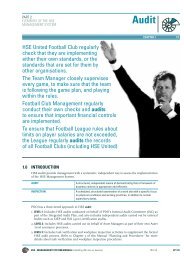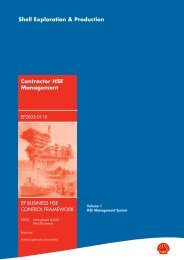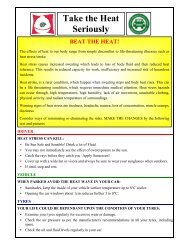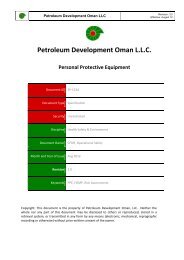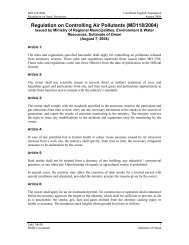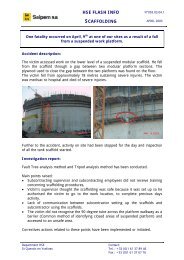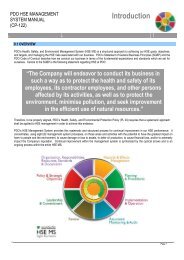Estate Service Asset - PDO
Estate Service Asset - PDO
Estate Service Asset - PDO
You also want an ePaper? Increase the reach of your titles
YUMPU automatically turns print PDFs into web optimized ePapers that Google loves.
Petroleum Development Oman<br />
<strong>Estate</strong> <strong>Service</strong>s <strong>Asset</strong><br />
Environmental Assessment<br />
2002 Review and Update<br />
DGs are operated very infrequently and only during grid failures. The incinerator for<br />
clinical waste is operated for a total of 6 hours monthly (on an average of once a<br />
week for few hours). The only areas provided with vents are the kitchens attached to<br />
the restaurants. From these vents, air laden with odours generated from the kitchens is<br />
released into the outside atmosphere.<br />
With respect to the area sources of air emissions, the only significant sources are the<br />
STPs, which may release odours into the atmosphere, if adequate aerobic conditions<br />
are not maintained. Since such conditions rarely exist, air emissions from area sources<br />
are considered insignificant.<br />
With respect to the mobile air emission sources, construction equipment are not<br />
significant sources of air emissions since no major construction activities are carried<br />
by estate services asset. However, if any renovations or temporary construction takes<br />
place in the asset area, the air emissions should be considered.<br />
The emissions from the passenger and transportation vehicles may be considered<br />
significant within the areas serviced by the estate services. Even though not many<br />
vehicles are used by the estate services staff or the contractor staff, a large number of<br />
vehicles enter and leave the MAF industrial area to visit the several departments of<br />
<strong>PDO</strong>. However, the roads within the areas serviced by estate services are not<br />
accessible to general public.<br />
4.2.2 Emissions from Incinerator<br />
Emissions from the incinerator stack, though intermittent are somewhat significant<br />
due to the potential for the release of extremely toxic gases from thermal degradation<br />
of clinical wastes, which include waste cotton, soiled bandages and used disposal<br />
syringes and needles. The quantity of clinical waste is however quite small (200<br />
kg/month) and the incinerator is operated only once a month for about 6 hours. The<br />
high temperature incinerator is fuelled by kerosene and ignited electronically. It has a<br />
design capacity of about 200 kg load. It consists of a primary chamber, which is<br />
heated to 425 o C and a secondary chamber, which heated to 925 o C. A strong air<br />
blower is provided to circulate the gases between the primary and secondary<br />
chambers. The incineration process is initiated by igniting the secondary chamber<br />
burner and allowing it to reach its operational temperature. The air blower and<br />
primary chamber automatically begin operating 1 hour later and the waste is<br />
continually incinerated for 3 hours. The secondary burner remains active for one more<br />
hour to complete the incineration cycle. The incinerator is allowed to cool and once<br />
©HMR Environmental Engineering Consultants C4 - 2<br />
Oman’s Environmental Consultancy<br />
HMR\1501\<strong>Estate</strong> <strong>Service</strong>s




